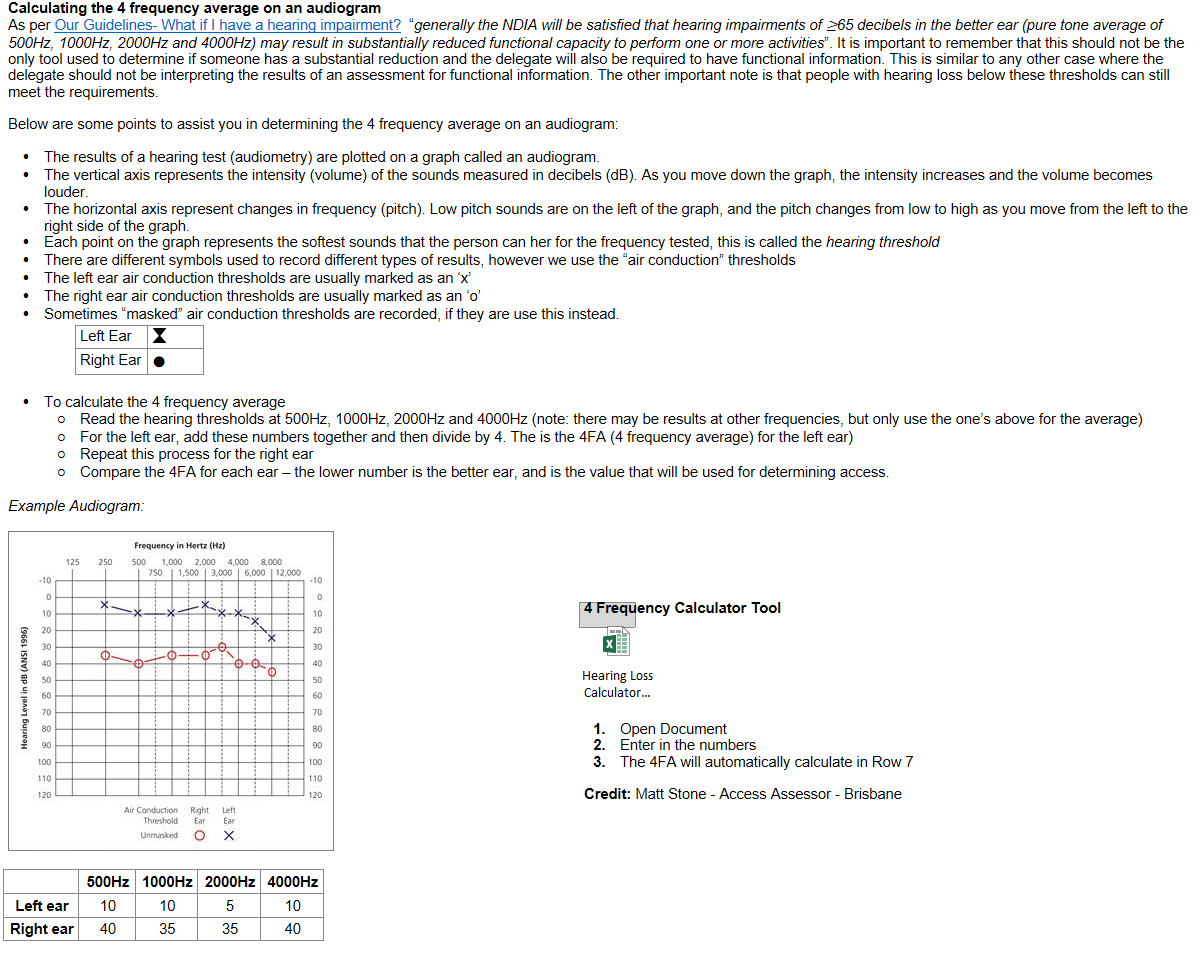DISCLOSURE LOG - FOI 24/25-1946
DOCUMENT 1
Access assessor OneNote
Hearing Impairments
The content of this document is OFFICIAL
Binaural (bilateral/cochlear implant in both ears) cochlear implants
Meet List A and an unaided audiogram is not required
Severe-Profound Hearing Loss - No Audiogram
For applicant's with severe-profound hearing loss who do not have an audiogram, if
there is sufficient functional information (i.e. Auslan is the primary mode of
communication) and
audiogram is preferred, but not required
Early Intervention – Hearing Requirements
For people aged between 0-25 years (under 26) with a hearing impairment, two adjacent
inter-octave frequencies are any frequencies that are different to 500, 1000, 2000 and
4000. Audiogram testing can stil be completed at the intervals between and outside of
these octaves which is when an inter-octave frequency is determined.
The below are some examples of octave and inter-octave frequencies which you might
see on an Audiogram. Please note that this is not an exhaustive list and only used as an
example.
•
250Hz and 500Hz
•
500Hz and 750Hz
•
2000Hz and 3000Hz
Adjacent Frequencies – Early Intervention
Assessing hearing loss for people aged between 0-25 years (under 26), when
considering the second dot point – ‘has confirmed results from a specialist audiological
assessment (including electrophysiological testing when required) consistent with
auditory neuropathy or the evidence (audiogram/table) requires hearing loss ≥ 25
decibels in either ear at 2 or more adjacent frequencies.
Page 1 of 4

FOI 24/25-1946
When assessing priority hearing cases for a child younger than 7. If the audiogram and
the table included in the hearing form has only 2 recorded frequencies, these become
the adjacent frequencies. This can be due to the difficulties associated with testing
young children.
Below is an example of hearing loss in the right ear that is ≥ 25 decibels in either ear at
2 frequencies that are
not adjacent. Therefore not meeting Early Intervention in line with
9.5.2 Early intervention for hearing impairment for people aged 0-25.
dec
Audiogram Requirement - Early Intervention
For the 0-25 year old cohort that have a primary impairment of hearing loss we need to
have an audiogram attached with their access request if we are bringing them in under
Our Guideline- What about people aged between 0 and 25 with a hearing impairment?
This is because the audiogram determines if there are 2 adjacent frequencies where
hearing loss is greater than or equal to 25 decibels. The exception to this is if the person
is diagnosed with auditory neuropathy we do not need the audiogram.
If we have the table provided with the numbers, but no audiogram please contact the
audiologist to confirm if an audiogram can be provided. In some circumstances they
can't. Please record this on the record and progress based on the table.
0-25 Hearing Loss – Clarification of Our Guidelines
The phrases of Long Term and Personal Amplification have been removed from Our
Guidelines, however the way we assess has not changed.
•
Long Term – As we are making a legislative decision, the evidence must
demonstrate the hearing loss must be permanent, or likely to be
permanent.
Page 2 of 4
FOI 24/25-1946
•
Personal Amplification – being aged 0-25 and having hearing loss of at
least 25 decibels in either ear, at 2 or more adjacent frequencies means
that the hearing loss is at an “aidable” level. Therefore, if we can see that
it was at an “aidable” level then this means it meets the criteria of
requiring personal amplification. The reason it was removed from Our
Guidelines is because the previous wording insinuated that personal
amplification
must be used, however there are a variety of reasons that a
person may not use personal amplification.
Page 3 of 4


DISCLSOURE LOG FOI 24/25-1946
DOCUMENT 2
Calculating the 4 Frequency Average
The content of this document is OFFICIAL
Page 4 of 4
Document Outline


